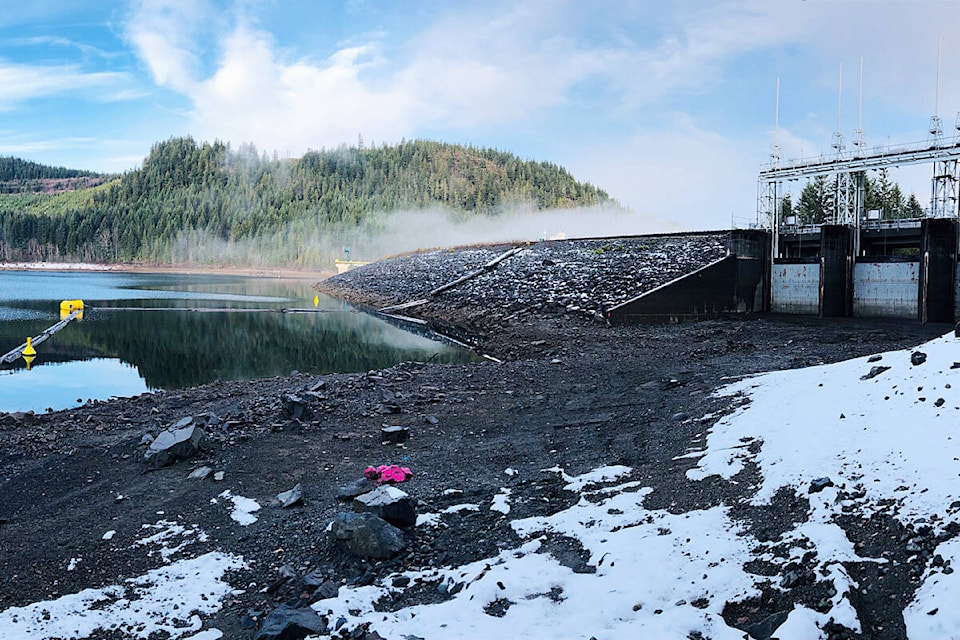BC Hydro reduced the Campbell River flow by nine per cent on Tuesday, and a similar flow reduction began today (Friday), in an ongoing response to the record dry fall conditions within the watershed.
The upstream reservoirs are low and the water inflows into the reservoirs are very low, BC Hydro spokesperson Stephen Watson said.
“Water storage is very low on the Campbell River system and our other Vancouver Island hydroelectric watersheds, though we are fortunate to have an integrated provincial system and the supply of power is currently not an issue with our large hydroelectric systems in the Interior,” Watson says.
The three powerhouses within the watershed are running at low levels because of the low water levels.
This fall, since Sept. 23, the upper Campbell River watershed has had the lowest precipitation in 41 years of record. There’s been 368 mm of precipitation, with the average over this time period being 841 mm. That’s a deficit of 473 mm or about 47 cm of water.
“We’ve received only about 44 per cent of normal precipitation,” Watson says. “For water inflows in the reservoir, this has also set a new fall season 53-year record with inflows coming in at about 28 per cent of normal. By comparison, over the same period in 2021, there was 1,154 mm of precipitation in the upper watershed.
The snowpack is about 50 per cent of normal for this time of year though there is lots of time to recover, Watson says. The snowpack typically peaks in April.
The Upper Campbell Reservoir/Buttle Lake behind the Strathcona Dam, is currently at about 212.2 metres. That represents about 80 per cent of the system water storage. The normal minimum and maximum reservoir elevations are between 212 metres and 220.5 metres. With the reservoir level below the sill of the spillway gates, and one of the two generators in the Strathcona powerhouse out of service, BC Hydro ran the generator a little harder to move water into Lower Campbell Reservoir/McIvor Lake as a contingency should the second generator go offline. This would provide suitable time to continue providing downstream river flows and get the generator up and running again.
The Lower Campbell Reservoir/McIvor Lake level is currently where it should be for this time of year, though, for operational flexibility reasons but it has been declining. The current level is 176.7 metres, and the normal minimum and maximum reservoir elevations are between 174 metres and 178.5 metres. Once the two Strathcona powerhouse generators are running, the two reservoirs will slightly rebalance. However, there is little water storage within the system.
Water inflows into the Campbell River system are only about 15 cubic metres per second (m3/s) this week.
The river flow that keeps the Campbell River riverbed fully covered with water use about 80 m3/s. Much of this fall BC hydro has been providing about 65 m3/s. With lower conservation flows in place all fall, the distribution of salmon spawning activity was a little different.
“On Tuesday we reduced the river flow from 55 m3/s to 50 m3/s, and on Friday we plan to reduce to 45 m3/s,” Watson says. “Our fish biologists have been monitoring for the possible stranding of small fish, as well as the water depth at fish spawning areas called redds. The goal is to keep as many salmon eggs as possible covered with water. Should the dry water inflow conditions persist, we will continue to monitor the river conditions and consider options for possible further flow reductions.”
The overall Campbell River reservoir storage and the Campbell River flow are both at record lows for this time of year.
BC Hydro will continue to focus operations on environmental efforts until some significant storms may hit the watershed. The next two weeks look to be dry and cool, thereby extending the very dry conditions and the need to reduce downstream river flows.
